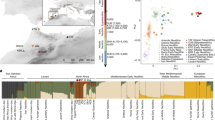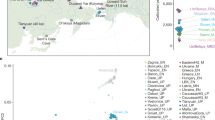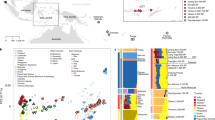Abstract
Despite broad agreement that the Americas were initially populated via Beringia, the land bridge that connected far northeast Asia with northwestern North America during the Pleistocene epoch, when and how the peopling of the Americas occurred remains unresolved1,2,3,4,5. Analyses of human remains from Late Pleistocene Alaska are important to resolving the timing and dispersal of these populations. The remains of two infants were recovered at Upward Sun River (USR), and have been dated to around 11.5 thousand years ago (ka)6. Here, by sequencing the USR1 genome to an average coverage of approximately 17 times, we show that USR1 is most closely related to Native Americans, but falls basal to all previously sequenced contemporary and ancient Native Americans1,7,8. As such, USR1 represents a distinct Ancient Beringian population. Using demographic modelling, we infer that the Ancient Beringian population and ancestors of other Native Americans descended from a single founding population that initially split from East Asians around 36 ± 1.5 ka, with gene flow persisting until around 25 ± 1.1 ka. Gene flow from ancient north Eurasians into all Native Americans took place 25–20 ka, with Ancient Beringians branching off around 22–18.1 ka. Our findings support a long-term genetic structure in ancestral Native Americans, consistent with the Beringian ‘standstill model’9. We show that the basal northern and southern Native American branches, to which all other Native Americans belong, diverged around 17.5–14.6 ka, and that this probably occurred south of the North American ice sheets. We also show that after 11.5 ka, some of the northern Native American populations received gene flow from a Siberian population most closely related to Koryaks, but not Palaeo-Eskimos1, Inuits or Kets10, and that Native American gene flow into Inuits was through northern and not southern Native American groups1. Our findings further suggest that the far-northern North American presence of northern Native Americans is from a back migration that replaced or absorbed the initial founding population of Ancient Beringians.
This is a preview of subscription content, access via your institution
Access options
Access Nature and 54 other Nature Portfolio journals
Get Nature+, our best-value online-access subscription
$29.99 / 30 days
cancel any time
Subscribe to this journal
Receive 51 print issues and online access
$199.00 per year
only $3.90 per issue
Buy this article
- Purchase on Springer Link
- Instant access to full article PDF
Prices may be subject to local taxes which are calculated during checkout




Similar content being viewed by others
Accession codes
References
Reich, D. et al. Reconstructing Native American population history. Nature 488, 370–374 (2012)
Raghavan, M. et al. Genomic evidence for the Pleistocene and recent population history of Native Americans. Science 349, aab3884 (2015)
Skoglund, P. et al. Genetic evidence for two founding populations of the Americas. Nature 525, 104–108 (2015)
von Cramon-Taubadel, N., Strauss, A. & Hubbe, M. Evolutionary population history of early Paleoamerican cranial morphology. Sci. Adv. 3, e1602289 (2017)
Hoffecker, J. F., Elias, S. A., O’Rourke, D. H., Scott, G. R. & Bigelow, N. H. Beringia and the global dispersal of modern humans. Evol. Anthropol. 25, 64–78 (2016)
Potter, B. A., Irish, J. D., Reuther, J. D. & McKinney, H. J. New insights into Eastern Beringian mortuary behavior: a terminal Pleistocene double infant burial at Upward Sun River. Proc. Natl Acad. Sci. USA 111, 17060–17065 (2014)
Rasmussen, M. et al. The genome of a Late Pleistocene human from a Clovis burial site in western Montana. Nature 506, 225–229 (2014)
Raghavan, M. et al. Upper Palaeolithic Siberian genome reveals dual ancestry of Native Americans. Nature 505, 87–91 (2014)
Tamm, E. et al. Beringian standstill and spread of Native American founders. PLoS One 2, e829 (2007)
Flegontov, P. et al. Na-Dene populations descend from the Paleo-Eskimo migration into America. Preprint at https://doi.org/10.1101/074476 (2016)
Dillehay, T. D. et al. Monte Verde: seaweed, food, medicine, and the peopling of South America. Science 320, 784–786 (2008)
Goebel, T. & Potter, B. A. in The Oxford Handbook of the Prehistoric Arctic (eds Friesen, T. M. & Mason, O. K. ) 223–252 (Oxford Univ. Press, 2016)
Llamas, B. et al. Ancient mitochondrial DNA provides high-resolution time scale of the peopling of the Americas. Sci. Adv. 2, e1501385 (2016)
Rasmussen, M. et al. The ancestry and affiliations of Kennewick Man. Nature 523, 455–458 (2015)
Raghavan, M. et al. The genetic prehistory of the New World Arctic. Science 345, 1255832 (2014)
Rasmussen, M. et al. Ancient human genome sequence of an extinct Palaeo-Eskimo. Nature 463, 757–762 (2010)
Tackney, J. C. et al. Two contemporaneous mitogenomes from terminal Pleistocene burials in eastern Beringia. Proc. Natl Acad. Sci. USA 112, 13833–13838 (2015)
Verdu, P. et al. Patterns of admixture and population structure in native populations of northwest North America. PLoS Genet. 10, e1004530 (2014)
Patterson, N. et al. Ancient admixture in human history. Genetics 192, 1065–1093 (2012)
Alexander, D. H., Novembre, J. & Lange, K. Fast model-based estimation of ancestry in unrelated individuals. Genome Res. 19, 1655–1664 (2009)
Skotte, L., Korneliussen, T. S. & Albrechtsen, A. Estimating individual admixture proportions from next generation sequencing data. Genetics 195, 693–702 (2013)
Malaspinas, A.-S. et al. bammds: a tool for assessing the ancestry of low-depth whole-genome data using multidimensional scaling (MDS). Bioinformatics 30, 2962–2964 (2014)
Pickrell, J. K. & Pritchard, J. K. Inference of population splits and mixtures from genome-wide allele frequency data. PLoS Genet. 8, e1002967 (2012)
Dyke, A. S., Moore, A. & Robertson, L. Deglaciation of North America. (Natural Resources Canada, 2003)
Pedersen, M. W. et al. Postglacial viability and colonization in North America’s ice-free corridor. Nature 537, 45–49 (2016)
Kari, J. M. & Potter, B. A. (eds) The Dene–Yeniseian Connection (Univ. Alaska, 2011)
Steinrücken, M., Kamm, J. A. & Song, Y. S. Inference of complex population histories using whole-genome sequences from multiple populations. Preprint at https://doi.org/10.1101/026591 (2015)
Kamm, J. A., Terhorst, J. & Song, Y. S. Efficient computation of the joint sample frequency spectra for multiple populations. J. Comput. Graph. Stat. 26, 182–194 (2017)
Terhorst, J., Kamm, J. A. & Song, Y. S. Robust and scalable inference of population history from hundreds of unphased whole genomes. Nat. Genet. 49, 303–309 (2017)
Goebel, T. The ‘microblade adaptation’ and recolonization of Siberia during the late Upper Pleistocene. Archaeol. Pap. Am. Anthropol. Assoc. 12, 117–131 (2002)
Allentoft, M. E. et al. Population genomics of Bronze Age Eurasia. Nature 522, 167–172 (2015)
Lindgreen, S. AdapterRemoval: easy cleaning of next-generation sequencing reads. BMC Res. Notes 5, 337 (2012)
Li, H. & Durbin, R. Fast and accurate short read alignment with Burrows–Wheeler transform. Bioinformatics 25, 1754–1760 (2009)
Schubert, M. et al. Improving ancient DNA read mapping against modern reference genomes. BMC Genomics 13, 178 (2012)
DePristo, M. A. et al. A framework for variation discovery and genotyping using next-generation DNA sequencing data. Nat. Genet. 43, 491–498 (2011)
Li, H. et al. The sequence alignment/map format and SAMtools. Bioinformatics 25, 2078–2079 (2009)
Delaneau, O., Zagury, J.-F. & Marchini, J. Improved whole-chromosome phasing for disease and population genetic studies. Nat. Methods 10, 5–6 (2013)
Fu, Q. et al. A revised timescale for human evolution based on ancient mitochondrial genomes. Curr. Biol. 23, 553–559 (2013)
Green, R. E. et al. A complete Neandertal mitochondrial genome sequence determined by high-throughput sequencing. Cell 134, 416–426 (2008)
Racimo, F., Renaud, G. & Slatkin, M. Joint estimation of contamination, error and demography for nuclear DNA from ancient humans. PLoS Genet. 12, e1005972 (2016)
Orlando, L. et al. Recalibrating Equus evolution using the genome sequence of an early Middle Pleistocene horse. Nature 499, 74–78 (2013)
Korneliussen, T. S. & Moltke, I. NgsRelate: a software tool for estimating pairwise relatedness from next-generation sequencing data. Bioinformatics 31, 4009–4011 (2015)
Albrechtsen, A. et al. Relatedness mapping and tracts of relatedness for genome-wide data in the presence of linkage disequilibrium. Genet. Epidemiol. 33, 266–274 (2009)
Korneliussen, T. S., Albrechtsen, A. & Nielsen, R. ANGSD: analysis of next generation sequencing data. BMC Bioinformatics 15, 356 (2014)
Green, R. E. et al. A draft sequence of the Neandertal genome. Science 328, 710–722 (2010)
Leppälä, K., Nielsen, S. V. & Mailund, T. admixturegraph: an R package for admixture graph manipulation and fitting. Bioinformatics 33, 1738–1740 (2017)
Acknowledgements
The Upward Sun River excavations and analysis were conducted under a Memorandum of Agreement (MOA) signed by the State of Alaska, the National Science Foundation, the Healy Lake Tribal Council and the Tanana Chiefs Conference. We appreciate the cooperation of all parties. We thank M. Allentoft, S. Gopalakrishnan, T. Korneliussen, P. Librado, J. Ramos-Madrigal, G. Renaud and F. Vieira for discussions, and the Danish National High-throughput Sequencing Centre for assistance with data generation. GeoGenetics members were supported by the Lundbeck Foundation and the Danish National Research Foundation (DNRF94) and KU2016. J.V.M.-M. was supported by Conacyt (Mexico). Samples were recovered during excavations by B.A.P. supported by NSF Grants 1138811 and 1223119. Research was supported in part by NIH grant R01-GM094402 (M.St., J.T., J.A.K. and Y.S.S.) and a Packard Fellowship for Science and Engineering (Y.S.S.). Y.S.S. is a Chan Zuckerberg Biohub investigator. D.J.M. is supported by the Quest Archaeological Research Fund. A.-S.M. is supported by the Swiss National Science Foundation and the ERC.
Author information
Authors and Affiliations
Contributions
The project was conceived by E.W. and B.A.P. and headed by E.W. L.V. processed ancient DNA. J.V.M.-M. and S.R. assembled datasets. J.V.M.-M., M.St., J.T., J.A.K. and A.A. analysed genetic data. B.A.P. led the USR field investigation and B.A.P. and D.J.M. provided anthropological contextualization. B.A.P., J.D.R. and J.D.I. conducted archaeological and bioanthropological work. R.N., Y.S.S., M.Si., A.-S.M., and L.O. supervised bioinformatic and statistical analyses. B.A.P. engaged with indigenous communities. J.V.M.-M., B.A.P., D.J.M. and E.W. wrote the manuscript with input from L.V., A.-S.M., M.Si., R.S.M., L.O., Y.S.S, R.N. and the other authors.
Corresponding author
Ethics declarations
Competing interests
The authors declare no competing financial interests.
Additional information
Publisher's note: Springer Nature remains neutral with regard to jurisdictional claims in published maps and institutional affiliations.
Supplementary information
Supplementary Information
This file contains supplementary text 1 – 21, tables S1-S25 and figures S1-S30. (PDF 23149 kb)
Rights and permissions
About this article
Cite this article
Moreno-Mayar, J., Potter, B., Vinner, L. et al. Terminal Pleistocene Alaskan genome reveals first founding population of Native Americans. Nature 553, 203–207 (2018). https://doi.org/10.1038/nature25173
Received:
Accepted:
Published:
Issue Date:
DOI: https://doi.org/10.1038/nature25173
This article is cited by
-
More than a decade of genetic research on the Denisovans
Nature Reviews Genetics (2024)
-
The Allen Ancient DNA Resource (AADR) a curated compendium of ancient human genomes
Scientific Data (2024)
-
Imputation of ancient human genomes
Nature Communications (2023)
-
Genetic continuity of Indo-Iranian speakers since the Iron Age in southern Central Asia
Scientific Reports (2022)
-
Femoroacetabular impingement in ancient Nubia 1400-656 BC
Archives of Orthopaedic and Trauma Surgery (2022)
Comments
By submitting a comment you agree to abide by our Terms and Community Guidelines. If you find something abusive or that does not comply with our terms or guidelines please flag it as inappropriate.



